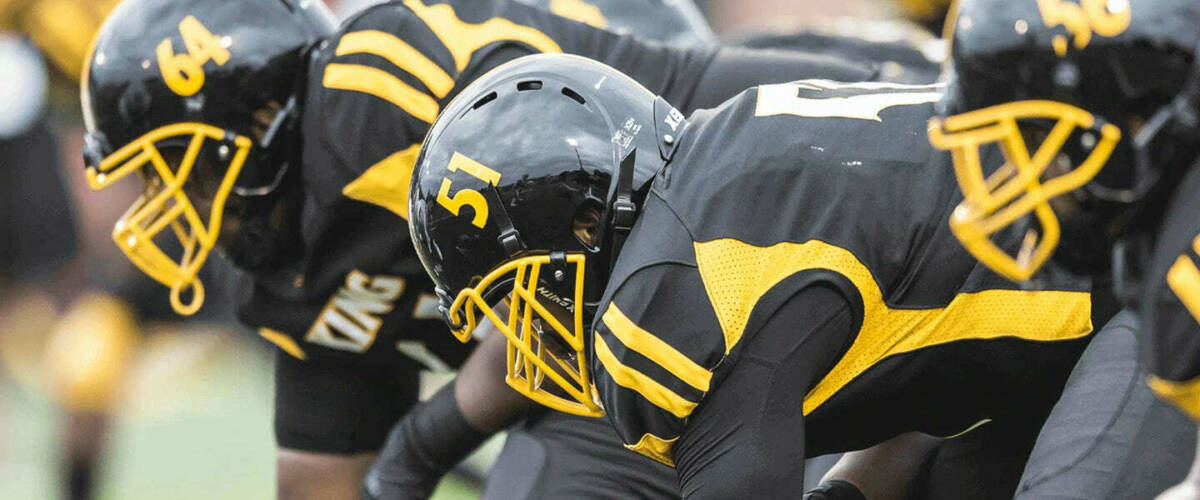
- Blog
- >
- The History of Football Helmets
The History of Football Helmets

August 27th, 2021
Keenan Crow
The history of football helmets is a fascinating story that seems destined to be made into a Netflix documentary. This article details the history of football helmets and how they were invented, and explains how they have improved over the years - advancing with technology and making the game safer for athletes.
Look inside just about any football player’s locker and you’ll find over a dozen products that provide protection, performance, comfort, and style to outfit them for play. Gloves, compression pieces, shoulder pads, and of course, a football helmet are all things you're likely to find in a football player's locker. Every product provides its own benefit to the player, but the football helmet is the centerpiece of protection and style. A player’s emotional connection to their helmet is stronger than any other piece of equipment. It's with them each time they take the field, and protects them during every play.
However, football helmets of years past were NOTHING like they are today. Read on to learn more about the history of football helmets and see how far the helmet design, and technology has come over the years.
The Father of Basketball (and Football Helmets)
Football helmets have come a long way since the original models. Believe it or not, football helmets were not always built with a polycarbonate or polymer outside shell, comfortable padding on the inside, or even a facemask!
Let’s rewind to Springfield, Massachusetts, 1891 when the game of football was changed forever. It was on these hallowed grounds that the invention of the football helmet was brought to life. James Naismith, the renowned “Father of Basketball,” had joined the YMCA College football team. Playing center for the squad, Naismith was the anchor of the offensive line and was repeatedly involved in physical contact while he blocked for his quarterback. After a barrage of hits to his head and face, Naismith came up with an idea. He had his girlfriend sew two pieces of flannel together to make the world’s first “football helmet.” This small spark of genius shifted the entire trajectory of the game of football.
From Flannel to Leather
In December of 1893, the world was introduced to the second version of the football helmet. The opportunity arose after a doctor told his football-playing patient, Navy Admiral Joseph Mason Reeves, that his participation in football would not have favorable long term health effects. The Admiral, a creative man himself, took matters into his own hands. This improvement from the original flannel football helmet to a leather helmet was produced by the Admiral’s shoemaker in Annapolis, Maryland. His padded, mushroom-shaped helmet design also transitioned to more applications other than the game of football; as Admiral Reeves’ helmet design was brought back to the Navy and was worn on the heads of paratroopers in World War I.
Strapping It Up
Most football players have heard, “time to strap it up” before a practice or game. That phrase comes from George Barclay. George refused to wear the latest iteration of helmets with his ears completely exposed due to his fear of developing cauliflower ear. So, in 1896 he developed a thick dome-shaped leather helmet which provided better protection and a more robust ear cap. This version of the football helmet included the first-ever chin strap; two leather strips that tied beneath the chin and kept the helmet on player’s heads as they grappled on the gridiron. The helmet paid off for Barclay as he led his team to an undefeated season and grabbed a share of the national title - sans cauliflower ear.
After a drought in innovation for a number of years, the ZH helmet was released in 1917. This updated leather helmet improved the ventilation, on-field communication, and protection aspects of football helmets. These helmets allowed for the forces of impact to be distributed across the head, instead of just one area, as you’ll see in current football helmets. Despite this amazing addition to the football helmet, there was still something missing.
Mask On
Exposed faces were getting kicked and cut during games which led to the development of facemasks. Facemasks brought about a massive modification to the football helmet industry. Vern McMillain, a sports salesman, brought the first facemask to the world in the form of rubber covered wire in 1935. The first facemask consisted of one bar that ran down the course of a player’s face protecting his nose. When looking at the facemask styles available today, such as the Prime or XRS-21s, it’s hard to imagine only having one bar.
From Leather to Plastic & The Mass Adoption of Football Helmets
It wasn't until 1939 that the NCAA mandated all players to wear football helmets in games. That same year, a company in Chicago began producing plastic helmets. Plastic helmets were manufactured with facemasks, chinstraps, and had improved strength as compared to their predecessors. Throughout the 40’s, plastic helmets became the standard for protection.
In 1943, the NFL also declared that all players must wear football helmets, which sparked the introduction of logos on helmets. The Los Angeles Rams pioneered this initiative when they added the iconic horns to their helmets. The addition of team logos to helmets brought a new identity to the game. Helmets were no longer a protective solid colored item; they became a sign of unity, spirit, and pride for teams. Logos and decals added swagger and style to a player’s image that had not previously existed causing drastic changes to team appearances.
Air Bladders
As years went by and science advanced, innovators challenged whether a hard plastic shell on its own was enough to protect football players. In the early 70’s, air pockets were added to the inside of the structure. This addition helped keep player’s heads more secure while simultaneously providing another layer of protection that impact must travel through.
In 1977, stainless steel facemasks were added to helmets giving them a much meaner look and stronger structure. This was the beginning of the creation of a wide variety of facemasks that transformed the personality of a helmet and further developed an athletes’ persona, brand, and identity on the football field.
Material Advancements
In the 80’s, a much lighter and more durable plastic – polycarbonate – became the primary helmet shell material used in the production of football helmets. The NFL used polycarbonate to improve head protection throughout the league. This was the beginning of the modern football helmet model, and during the 2000’s, helmets continued to improve as the focus shifted from preventing skull fractures to preventing concussions.

A New Era
In 2006, Xenith arrived on the scene of a football helmet industry that was ripe for disruption. With the introduction of the X1 helmet and its groundbreaking shock matrix technology in 2009, there was a paradigm shift in the way helmet companies thought about protection. This paved the way for a cascade of technological improvements as the market tried to keep up.

From a humble flannel cap made by John Naismith’s girlfriend to now, where the value of the American football helmet market was sized at $140 million as of 2017, the helmet industry has seen many evolutions. Since their mass adoption in the late 1930s, helmets have provided teams and their fanbases with an identity that evokes elements of passion, purpose, and pride. Football helmets allow players to express their style through facemask choice, helmet style, and selection of visor.
Now, with the introduction of Xenith Shadow and its revolutionary polymer shell and adaptive fit technology, Xenith is leading the charge on designing helmets that not only provide advanced protection, but also allow athletes to perform at their best on the field.



